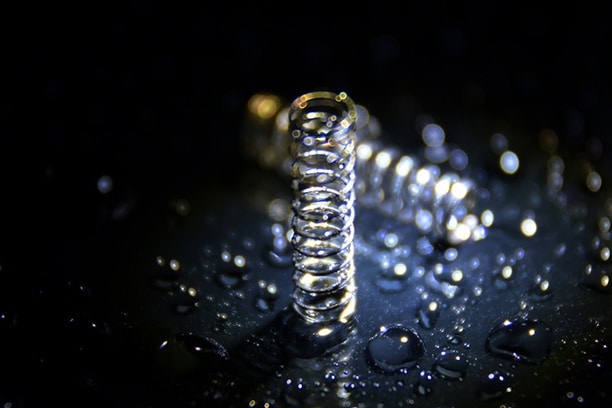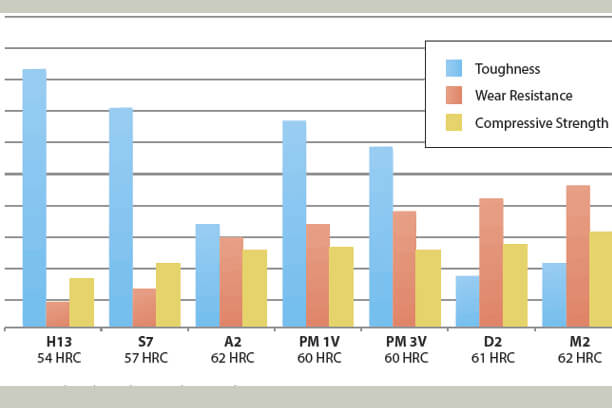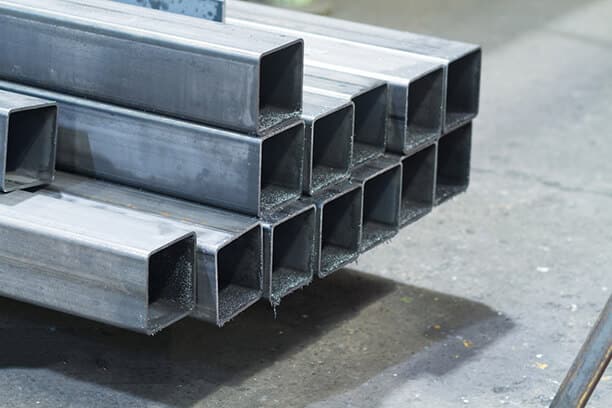Spring steel is an essential material for many industries, and it has specific qualities that outperform other types of steel. But what exactly is spring steel and why is it so practical? In this article, we’ll explore what spring steel is, its properties, different grades, how it’s formed, and where it’s commonly used.
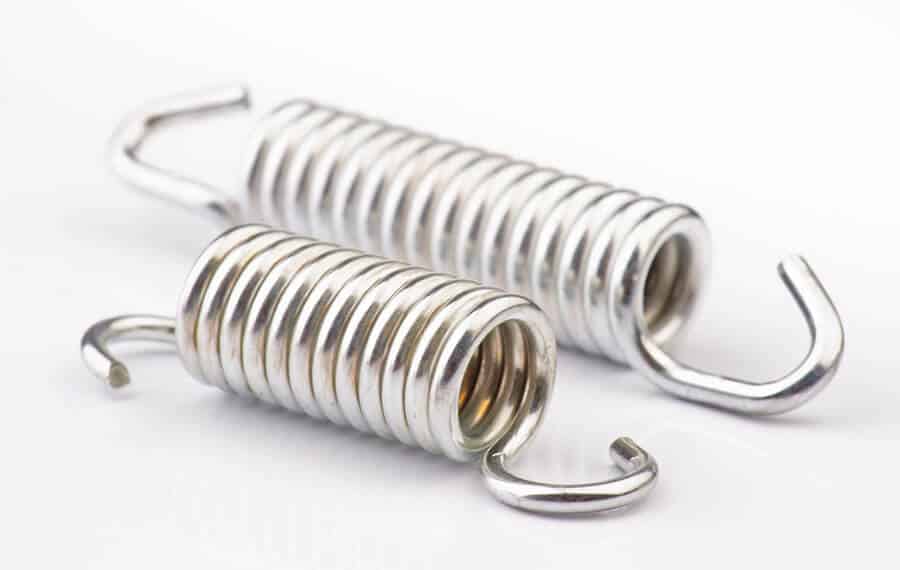
What is Spring Steel?
Spring steel is a type of steel that’s specifically used to make springs and elastic components because it can return to its original shape after being bent, compressed, or extended. This ability, known as elasticity in the quenched and tempered state, is due to the high yield strength of steel, which comes from its specific composition and hardening process.
Spring steels are typically made up of medium-to-high carbon content, usually around 0.5 to 1.0 percent. In addition to carbon, they also contain manganese and silicon, with silicon being particularly important in achieving high yield strengths. Products made from these steel alloys can endure continuous bending, compression, extension, or twisting without suffering any permanent deformation.
Manufacturing spring steel requires advanced technical skills to ensure high quality. Any imperfections on the surface, such as decarburization or irregularities, can reduce the fatigue strength. Therefore, it’s essential for manufacturers to ensure that the springs have a perfectly smooth surface for optimal efficiency and performance.
What are the Constituents of Spring Steel?
Spring steels are alloys with a medium-to-high carbon content, usually ranging from 0.5 to 1.0 percent. They also contain other alloy additives such as manganese, nickel, chrome, vanadium, and molybdenum.
However, the essential element in the composition of spring steels is silicon. This material is valued for its durability and ability to maintain its shape and flexibility, making it well-suited for spring steel applications and contributing to the material’s high yield strength. This flexibility allows the material to be deformed and then return to its original position once the load has been removed.
Here are some common spring steel grades and their chemical composition.
| Grade | C [%] | Si [%] | Mn [%] | P [%] max. | S [%] max. | Cr [%] max. / – | Mo [%] | Ni [%] max. | V [%] |
|---|---|---|---|---|---|---|---|---|---|
| C55S | 0.52 – 0.60 | 0.15 – 0.35 | 0.60 – 0.90 | 0.025 | 0.010 | 0.40 | 0.10 | 0.40 | – |
| C60S | 0.57 – 0.65 | 0.15 – 0.35 | 0.60 – 0.90 | 0.025 | 0.010 | 0.40 | 0.10 | 0.40 | – |
| C67S | 0.65 – 0.73 | 0.15 – 0.35 | 0.60 – 0.90 | 0.025 | 0.010 | 0.40 | 0.10 | 0.40 | – |
| C75S | 0.70 – 0.80 | 0.15 – 0.35 | 0.60 – 0.90 | 0.025 | 0.010 | 0.40 | 0.10 | 0.40 | – |
| C100S | 0.95 – 1.05 | 0.15 – 0.35 | 0.30 – 0.60 | 0.025 | 0.010 | 0.40 | 0.10 | 0.40 | – |
| 51CrV4 | 0.47 – 0.55 | 0.40 | 0.70 – 1.10 | 0.025 | 0.010 | 0.90 – 1.20 | 0.10 | 0.40 | 0.10 – 0.25 |
| 80CrV2 | 0.75 – 0.85 | 0.15 – 0.35 | 0.30 – 0.50 | 0.025 | 0.010 | 0.40 – 0.60 | 0.10 | 0.40 | 0.15 – 0.25 |
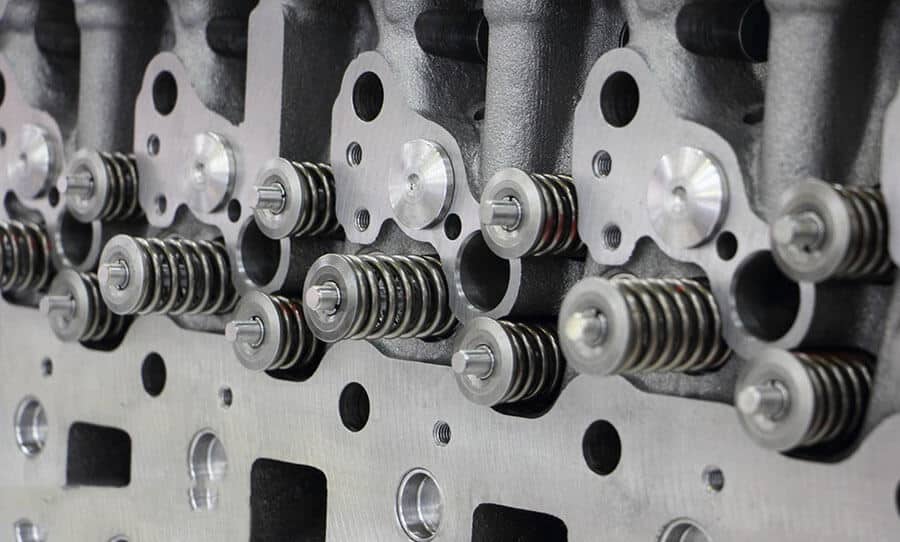
Classification of Spring Steel
As per the steel classification standard GB/T 13304, spring steel is categorized as steel for mechanical structures based on its fundamental performance and service characteristics. In terms of quality grade, it falls under the special quality steel category, requiring strict control over its quality and performance during production. In Chinese custom, spring steel is considered special steel.
Based on the chemical composition, spring steel is further classified into carbon spring steels, alloy spring steels, stainless spring steels, copper-based spring alloys, and nickel-based spring alloys.
Here is the classification of spring steels based on their chemical compositions.
| Material | GB | JIS | ASTM/SAE | DIN |
|---|---|---|---|---|
| Stainless Steel | 1Cr18Ni9 | SUS302 | 302 | 1.4310 |
| 0Cr18Ni9 | SUS304 | 304 | X5CrNi18-10 | |
| 0Cr17Ni12Mo2 | SUS316 | 316 | X5CrNi17.12.2 | |
| 07Cr17Ni7A1 | SUS631 | SAE17-7 | X7CrNiAL17.7 | |
| Nickel-based | GH4169 GH169 | InconelX-718 | NiCrl9Fe19Nb5、Mo3 | |
| GH145/GH4145 | NCF750 | Incone1X-750 | NiCr15Fe7TiAl | |
| Elgiloy | ||||
| Alloy-based | 60Si2MnA | SUP6 | SAE9260 | 60Si7 |
| 55CrSi | SWOSC-V | |||
| 50CrVA | SUS10A | 6150 | 67SiCr5 | |
| 60Si2CrA | SUP12 | SAE9254 | 67SiCr5 | |
| 30W4Cr2VA | ||||
| Carbon-based | 65Mn | 1066 | Ck67 | |
| Music Wire | SWP-B/ SWP-A | |||
| Copper-based | QSn4-3(Tin Bronze) | C3712 | C28000 | CuZn40 |
| QSi3-1(Silicon Bronze) | C6561 | |||
| QBe2(Beryllium Bronze) | C1720 | C17200 | ||
| Monel 400 | NW4400 | UNS N04400 | 2. 4360 | |
| Monel K500 | NW5500 | UNS N05500 | 2. 4375 |
65Mn
Chemical Composition
| Grade | Standard | C | Si | Mn | S | P | Cr | Ni | Cu |
| 65Mn | GB/T 1222-2007 | 0.62~0.70 | 0.17~0.37 | 0.90~1.20 | ≤0.035 | ≤0.035 | ≤0.25 | ≤0.25 | ≤0.25 |
Mechanical Properties
| Tensile Strength Rb(MPa) | Yield Strength Rs (MPa) | Shear Modulus G/x103(MPa) | Elastic Modulus E/x103(MPa) | Recommended Temp |
| 980(φ=10mm) | 785 | 78.8 | 196.0 | -40~120 |
Characteristics & Application
65Mn is a kind of high-carbon steel. It has simple composition and low cost. Manganese is added to improve hardenability. Its comprehensive mechanical properties, decarburization, and other properties are better than carbon steel. But 65Mn is sensitive to elevated treatment and cracking easily when quenching.
65Mn is commonly used to manufacture a variety of round springs, clockwork, spring rings, vibration dampers, and clutch springs.
Music Wire
Chemical Composition
| Grade | Standard | C | Si | Mn | S | P | Cu |
| SWP-B | JIS_G3522 | 0.60~0.95 | 0.12~0.32 | 0.30~0.90 | ≤0.025 | ≤0.025 | ≤0.20 |
Mechanical Properties
| Tensile Strength Rb(MPa) | Yield Strength Rs (MPa) | Shear Modulus G/x103(MPa) | Elastic Modulus E/x103(MPa) | Recommended Temp |
| 2260~2450(φ=1.0mm) | 1568 | 78.7 | 196.0 | -40~120 |
Characteristics & Application
Music wire is cold drawn after quenching in a lead bath. It is a high spring with very high strength, elasticity, and fatigue resistance. It is a widely used small spring material and is used to manufacture various important springs, various high-stress mechanical springs, and valve springs.
60Si2Mn
Chemical Composition
| Grade | Standard | C | Si | Mn | S | P | Cr | Ni | Cu |
| 60Si2Mn | GB/T 1222-2007 | 0.54~0.60 | 1.5~2.0 | 0.70~1.00 | ≤0.035 | ≤0.035 | ≤0.35 | ≤0.35 | ≤0.25 |
Mechanical Properties
| Tensile Strength Rb(MPa) | Yield Strength Rs (MPa) | Shear Modulus G/x103(MPa) | Elastic Modulus E/x103(MPa) | Recommended Temp |
| 1274(φ=10mm) | 1170 | 78.8 | 196.0 | -40~200 |
Characteristics & Application
The manganese in 60Si2Mn can improve the hardenability. Due to its high silicon content, its strength, hardenability, and tempering resistance are higher than those of carbon spring steel. However, due to its high silicon content, it has a high likelihood of surface decarburization and low cold deformation plasticity. After quenching and tempering, it has a higher yield-strength ratio, anti-relaxation ability, and tempering stability, especially the fatigue life is significantly improved.
60Si2Mn is suitable for manufacturing coil springs with a thickness of cross-section less than 25mm, and is widely used in heavy machinery, railway vehicles, and automobiles.
55CrSi
Chemical Composition
| Grade | Standard | C | Si | Mn | Cr | S | P | Ni | Cu |
| 55CrSi | GB/T 1222-2007 | 0.50~0.60 | 1.2~1.6 | 0.50~0.80 | 0.50~0.80 | ≤0.030 | ≤0.030 | ≤0.20 | ≤0.20 |
Mechanical Properties
| Tensile Strength Rb(MPa) | Yield Strength Rs (MPa) | Shear Modulus G/x103(MPa) | Elastic Modulus E/x103(MPa) | Recommended Temp |
| 1862 (φ≥4.2mm) | 1666 | 78.8 | 196.0 | -40~250 |
Characteristics & Application
55CrSi spring steel has high fatigue resistance and high relaxation resistance. Because the mass fraction of Si in it is relatively high, the elastic limit, yield-to-strength ratio, and resistance to fatigue can be significantly improved. Cr element is also added to enhance the mechanical properties. Cr has low sensitivity to elevated treatment, helping to eliminate the graphitization tendency of Si-containing spring steel.
55CrSi is widely used in the manufacture of brake springs, solid stabilizer bars, torsion bars, valve springs, shock absorber springs for high-end motorcycles, and mechanical springs for important purposes.
50CrVA
Chemical Composition
| Grade | Standard | C | Si | Mn | Cr | V | S | P | Ni | Cu |
| 50CrVA | GB/T 1222-2007 | 0.46~0.54 | 0.17~0.37 | 0.50~0.80 | 0.80~1.10 | 0.10~0.20 | ≤0.03 | ≤0.03 | ≤0.35 | ≤0.25 |
Mechanical Properties
| Tensile Strength Rb(MPa) | Yield Strength Rs (MPa) | Shear Modulus G/x103(MPa) | Elastic Modulus E/x103(MPa) | Recommended Temp |
| 1274 (φ=10mm) | 1127 | 78.8 | 196.0 | -40~250 |
Characteristics & Application
50CrVA has good mechanical properties and high hardenability. The vanadium is integrated to refine the grains of steel, thus improving strength, toughness, and heat resistance. However, its weldability is poor. 50CrVA is a high-grade spring steel, used for large-section and high-load applications such as valve springs, piston springs, and safety valve springs.
30W4Cr2VA
Chemical Composition
| Grade | Standard | C | Si | Mn | Cr | V | W | S | P | Ni | Cu |
| 30W4Cr2VA | GB/T 1222-2007 | 0.26~0.34 | 0.17~0.37 | ≤0.04 | 2.00~2.50 | 0.50~0.80 | 4~4.5 | ≤0.03 | ≤0.03 | ≤0.35 | ≤0.25 |
Mechanical Properties
| Tensile Strength Rb(MPa) | Yield Strength Rs (MPa) | Shear Modulus G/x103(MPa) | Elastic Modulus E/x103(MPa) | Recommended Temp |
| 1470 (φ=10mm) | 1323 | 81.8~78.7 | 206.0~196.2 | -40~500 |
Characteristics & Application
30W4Cr2VA contains tungsten, chromium, and vanadium. The main function of tungsten (w) is to improve the quenching ability and heat resistance of steel, so that the spring maintains high strength and elasticity at high temperatures. Tungsten can also improve tempering stability and hot workability. It is used in the quenched and tempered state and used as heat-resistant springs, such as main safety valve springs in boilers, etc.
60Si2CrA
Chemical Composition
| Grade | Standard | C | Si | Mn | Cr | S | P | Ni | Cu |
| 60Si2CrA | GB/T 1222-2007 | 0.56~0.64 | 1.40~1.80 | 0.04~0.70 | 0.70~1.00 | ≤0.030 | ≤0.030 | ≤0.35 | ≤0.25 |
Mechanical Properties
| Tensile Strength Rb(MPa) | Yield Strength Rs (MPa) | Shear Modulus G/x103(MPa) | Elastic Modulus E/x103(MPa) | Recommended Temp |
| 1764 (φ=10mm) | 1568 | 81.8~78.7 | 206.0~196.2 | -40~250 |
Characteristics & Application
60Si2CrA is a high-strength spring steel. It has high hardenability and good heat treatment performance. Because of its high strength, the internal stress should be eliminated in time after rolling. 60Si2CrA can be used to manufacture steam turbine seal springs, adjustment springs, condenser support springs, high-pressure water pump disc springs, etc. It can also be used to make conventional weapon retrieval hook springs, crusher springs, and engineering machinery springs.
Stainless Spring Steel
Chemical Composition
| Grade | Standard | C | Si | Mn | S | Ni | Cr | P | Mo |
| SUS302 | JIS G4314 | ≤0.15 | ≤1.00 | ≤2.00 | ≤0.030 | 8.00-10.00 | 17.00-19.00 | ≤0.045 | |
| SUS304 | JIS G4314 | ≤0.15 | ≤1.00 | ≤2.00 | ≤0.030 | 8.00-10.00 | 17.00-19.00 | ≤0.045 | |
| SUS316 | JIS G4314 | ≤0.15 | ≤1.00 | ≤2.00 | ≤0.030 | 10.00-14.00 | 16.00-18.00 | ≤0.045 | 2.0~3.0 |
| SUS631 | JIS G4314 | ≤0.09 | ≤1.00 | ≤1.00 | ≤0.03 | 6.5-7.75 | 16.0-18.0 | ≤0.04 | Al 0.75~1.5 |
Mechanical Properties
| Grade | Tensile Strength Rb(MPa) | Tensile Strength Rs (MPa) | Shear Modulus G/x103(MPa) | Elastic Modulus E/x103(MPa) | Recommended Temp |
| SUS302/304 | 1863~2108 (φ=1mm) | ≥205 | 71.7 | 193.2 | -200~200 |
| SUS316 | 1863~2108 (φ=1mm) | ≥205 | 71.7 | 193.2 | -200~200 |
| SUS631 | 1705~2010 (φ=1mm) | ≥205 | 71.7 | 193.2 | -200~343 |
Characteristics & Application
As a widely used spring steel, it has good resistance to low temperature, corrosion, and heat.
- SUS302/304: Corrosion-, heat-resistant spring steel. Their mechanical properties are the same, but 304 is more corrosion-resistant than 302.
- SUS316: Due to the addition of Mo, its resistance to corrosion and high temperature is particularly good. It is usually used in navigation and resistance to chloride corrosion.
- SUS631: Higher strength than 300 series stainless steel. It has high strength, high hardness, and resistance to fatigue, heat, and corrosion. Used in aerospace, chemical, petrochemical, paper and metal processing industries.
Inconel 750
Chemical Composition
| Grade | Standard | C | Cr | Ni | Al | Ti | Fe | Nb | SI | Mn | S | Cu |
| Inconel X750 | AMS 5698 | ≤0.08 | 14.0~17.0 | ≥70.0 | 0.40~1.00 | 2.25~2.75 | 5.00~9.00 | 0.70~1.20 | ≤0.50 | 1.0 | ≤0.01 | ≤0.5 |
Mechanical Properties
| Tensile Strength Rb(MPa) | Yield Strength Rs (MPa) | Shear Modulus G/x103(MPa) | Elastic Modulus E/x103(MPa) | Recommended Temp |
| 1241~1793 | 790 | 82.7 | 214 | -260~550 |
Characteristics & Application
It’s a nickel-based alloy reinforced with Al, Ti, and Nb. Aluminum (A1), titanium (Ti), and niobium (Nb) are mainly added to stainless steel for springs or other spring materials for special purposes. The main purpose is to improve the corrosion resistance of the material. Ti is a strong deoxidizer in steel, which can refine grains and reduce sensitivity. Nb can refine grains and reduce overheating sensitivity, and brittleness of steel. It is one of the better alloys in the early Inconel alloy system. It has good strength, corrosion resistance, and oxidation resistance under 980℃.
Inconel X-750 alloy is mainly used to manufacture relaxation-resistant flat springs and coil springs that require higher strength.
Inconel 718
Chemical Composition
| Grade | Standard | C | Cr | Ni | Co | Al | Ti | Fe | Mo | Mn | SI | Cu |
| Inconel 718 | AMS 5662 | ≤0.08 | 17.0~21.0 | 50.0~55.0 | ≤1.0 | 0.20~0.80 | 0.65 | balance | 2.8~3.3 | ≤0.35 | ≤0.35 | ≤0.3 |
Mechanical Properties
| Tensile Strength Rb(MPa) | Yield Strength Rs (MPa) | Shear Modulus G/x103(MPa) | Elastic Modulus E/x103(MPa) | Recommended Temp |
| 1310~1515 | 1082 | 80 | 200 | -260~650 |
Characteristics & Application
Inconel 718 is a Fe-Ni-Cr alloy. It has excellent resistance to high temperatures and corrosion. It has high strength and good toughness below 650°C, as well as oxidation and corrosion resistance in high and low temperature environments. It can be widely used in various high-demand situations, such as steam turbines, fuel rocket cryogenic engineering, acidic environments, nuclear engineering, etc.
Elgiloy
Chemical Composition
| Grade | Standard | C | Co | Be | Cr | Fe | Mo | Mn | Si | Ni | S | P |
| Elgiloy | AMS 5833 | ≤0.15 | 39.0~41.0 | ≤0.1 | 19.0~21.0 | balance | 6.0~8.0 | 1.5~2.5 | ≤1.2 | 14.0~16.0 | ≤0.015 | ≤0.015 |
Mechanical Properties
| Tensile Strength Rb(MPa) | Yield Strength Rs (MPa) | Shear Modulus G/x103(MPa) | Elastic Modulus E/x103(MPa) | Recommended Temp |
| 1515-2000 | 77.2 | 190 | -184~454 |
Characteristics & Application
Elgiloy is a cobalt-chromium-nickel alloy. The addition of cobalt allows the material to reach a high elastic limit, and the alloy also has excellent corrosion resistance and fatigue resistance in many environments. It is suitable for applications where high corrosion resistance is required or low relaxation at temperatures up to 380°C is required. In seawater, Elgiloy alloy is almost immune to crevice corrosion and stress corrosion. It’s widely used for oil and gas extraction, medical, dental, aerospace, defense, space exploration and watchmaking.
Copper-based Spring Steel
Chemical Composition
| Grade | Standard | Cu | Sn | Zn | Al | Si | Ni | Fe | Be | Total Impurities |
| Tin Bronze | GB/T 13808 | balance | 3.5~4.5 | 2.7~3.3 | 0.002 | 0.002 | 0.05 | ≤1.5 | ||
| Silicon Bronze | GB/T 4423 | balance | 0.25 | 0.5 | 0.03(Pb) | 2.75~3.5 | 0.2 | 0.3 | 1.0~1.5(Mn) | ≤1.1 |
| Beryllium Bronze | GB/T 5231 | balance | 0.15 | 0.05(Pb) | 0.15 | 0.2 | 0.15 | 1.0~2.1 | ≤0.5 |
Mechanical Properties
| Grade | Tensile Strength Rb(MPa) | Yield Strength Rs (MPa) | Shear Modulus G/x103(MPa) | Elastic Modulus E/x103(MPa) | Recommended Temp |
| Tin Bronze | 780~1130 | 40207 | 93163 | -250~120 | |
| Silicon Bronze | 780~1130 | 40207 | 93163 | -40~120 | |
| Beryllium Bronze | 373~1275 | 42169 | 129448 | -200~120 |
Characteristics & Application
Tin bronze has good corrosion resistance in the atmosphere where a dense tin dioxide film is formed on the surface of tin bronze. The denser and thicker the tin dioxide film, the better the wear resistance. It is also corrosion-resistant in fresh water and seawater, and is suitable for manufacturing springs that require higher hardness and stronger wear resistance.
Silicon bronze contains manganese and nickel elements. It has high strength and strong corrosion resistance. It has high corrosion resistance in fresh water and seawater, and has good weldability and cutting properties. It’s used to manufacture friction parts (such as guide sleeves for engine exhaust and intake valves) and structural parts working in corrosive media.
Beryllium bronze contains 1.7~2.5% beryllium. The addition of beryllium makes it have excellent elasticity. It is a precipitation hardening alloy with good strength, hardness, elasticity, and fatigue resistance. It has a service life of more than 40 years in seawater. It is widely used and expensive, and is more suitable for manufacturing precision springs on electrical appliances.
MONEL
Chemical Composition
| Grade | Standard | Ni | Cu | Ti | Al | Mn | Si | C | Fe | S |
| Monel 400 | AMS 7233 | 63.0~70.0 | 28.0~34.0 | ≤2.0 | ≤0.5 | ≤0.3 | ≤2.5 | ≤0.024 | ||
| Monel K500 | QQ-N-286 | 63.0~70.0 | balance | 0.35~0.85 | 2.3~3.15 | ≤1.5 | ≤0.5 | ≤0.25 | ≤2.0 | ≤0.001 |
Mechanical Properties
| Grade | Tensile Strength Rb(MPa) | Yield Strength Rs (MPa) | Shear Modulus G/x103(MPa) | Elastic Modulus E/x103(MPa) | Recommended Temp |
| Monel 400 | 1000~1240 | 65.5 | 179 | -184~260 | |
| Monel K500 | 1100~1380 | 65.5 | 179 | -184~232 |
Characteristics & Application
Monel 400 is a nickel-copper alloy. This alloy has excellent corrosion resistance in hydrofluoric acid and fluorine gas media, and also has excellent corrosion resistance against hot concentrated alkali liquid. It is also resistant to corrosion from neutral solutions, water, seawater, atmosphere, organic compounds, etc.
Monel K500 is a precipitation hardened nickel-copper-aluminum alloy. The addition of titanium and aluminum elements increases the tensile strength of K500 to twice that of 400 alloys, and the yield strength is three times that of 400 alloys. The material remains ductile and tough at temperatures as low as -240°. K500 also offers spark resistance and excellent corrosion resistance to a wide range of chemical elements and maritime environments, such as salts, alkalis, acids, and non-oxidizing acids.
Properties of Spring Steel
Spring steel is widely used in the manufacturing of various types of springs and similar components. It is distinguished by its high yield strength, allowing products made from this material to endure continuous compression, bending, and twisting without losing their original shape.
Here are some key characteristics of spring steel:
- Resilience: Spring steel is highly resilient and can return to its original shape after being bent or stretched.
- Hardness and durability: It can bear heavy loads without breaking and is resistant to weathering and wear over time.
- Elasticity: Spring steel can be shaped, formed, and post-heat treated without losing its form.
- Corrosion resistance: It has high corrosion resistance, making it suitable for use in harsh conditions.
In addition to high yield strength, spring steels also possess excellent tensile strength and fatigue strength. These properties make spring steel suitable for a wide range of industrial applications.
The table below summarizes the yield and tensile strengths of different spring steel grades – EN 10132-2021.
| Material No. | Standard | Annealed to spheroidized cementite | Annealed to spheroidized cementite-dead soft | |||||||||||
| AISI | JIS | EN | DIN | Yield strength[MPa](max.) | Tensile strength[MPa](max.) | HBW(max.) | Yield strength[MPa](max.) | Tensile strength[MPa](max.) | HBW(max.) | |||||
| Metric | US | Metric | US | Metric/US | Metric | US | Metric | US | Metric/US | |||||
| 1.1231 | 1070 | SK7 | C67S | Ck 67 | 380 | 55 | 580 | 84 | 180 | 330 | 48 | 550 | 80 | 171 |
| 1.1248 | 1075 | SK6 | C75S | Ck 75 | 400 | 58 | 610 | 88 | 189 | 345 | 50 | 570 | 83 | 177 |
| 1.1284 | C80S | 400 | 58 | 610 | 88 | 189 | 345 | 50 | 570 | 83 | 177 | |||
| 1.1269 | 1086 | SK5 | C85S | Ck 85 | 405 | 59 | 620 | 90 | 192 | 355 | 51 | 580 | 84 | 180 |
| 1.1217 | C90S | 420 | 61 | 630 | 91 | 195 | 365 | 53 | 590 | 86 | 183 | |||
| 1.1274 | 1095 | SK4 SK3 | C100S | Ck 101 | 430 | 62 | 640 | 93 | 198 | 380 | 55 | 600 | 87 | 186 |
| 1.1224 | C125S | 440 | 64 | 650 | 94 | 202 | 400 | 58 | 620 | 90 | 192 | |||
| 1.2002 | SK2 | 125Cr2 | 125Cr1 | 450 | 65 | 660 | 96 | 205 | 385 | 56 | 640 | 93 | 198 | |
| 1.2235 | 80CrV2 | 80CrV 2 | 390 | 57 | 600 | 87 | 186 | 345 | 50 | 570 | 83 | 177 | ||
| 1.5026 | 9255 | 56Si7 | 420 | 61 | 620 | 90 | 192 | 360 | 52 | 580 | 84 | 180 | ||
| 1.5634 | SKS51 | 75Ni8 | 450 | 65 | 660 | 96 | 205 | 400 | 58 | 630 | 91 | 195 | ||
| 1.8159 | 6150 | SUP10 | 51CrV4 | 50 CrV 4 | 380 | 55 | 580 | 84 | 180 | 330 | 48 | 550 | 80 | 171 |
| 1.8161 | 58CrV4 | 58 CrV 4 | 390 | 57 | 590 | 86 | 183 | 350 | 51 | 560 | 81 | 174 | ||
| 1.2003 | 75Cr1 | 420 | 61 | 630 | 91 | 195 | 360 | 52 | 580 | 84 | 180 | |||
| 1.2018 | 95Cr1 | 430 | 62 | 640 | 93 | 198 | 380 | 55 | 600 | 87 | 186 | |||
| 1.6595 | 68CrNiMo3-3 | 400 | 58 | 615 | 89 | 190 | 350 | 51 | 575 | 83 | 179 | |||
How is Spring Steel Formed?
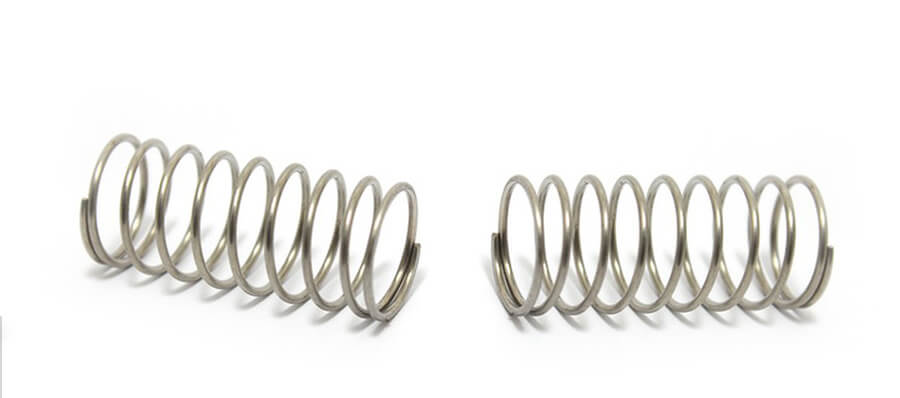
Spring steel can undergo various processes, such as hot and cold rolling, annealing, and heat treatment, depending on the grade of spring steel and the desired mechanical properties of the final product.
The process typically begins with melting and refining the raw materials to achieve the correct steel composition. The molten steel is then poured into large blocks or billets and allowed to cool. The billets can be additionally processed through either hot or cold rolling to decrease their thickness and improve their grain structure, effectively increasing the material’s tensile strength and producing spring steel sheets, strips, rods, and bars. Higher reductions lead to increased tensile strengths, but excessive tensile strength may cause the material to become brittle and susceptible to breakage. Cold rolling is commonly favored for high-quality spring steel due to its ability to provide finer control over the thickness and dimensional tolerances.
Upon rolling, the steel may be annealed to relieve internal stresses and enhance its ductility. This involves heating the steel to a specific temperature for a set duration and then allowing it to cool slowly in a controlled environment, thereby enhancing the toughness and flexibility of the steel.
Lastly, spring steel can undergo heat treatment to attain the desired mechanical properties. A specific percentage of carbon is essential to enable this process, typically ranging from 0.50% to 1.25% for carbon spring steels. This process includes heating the steel to a critical temperature and then quickly cooling it (quenching) to form a hard, brittle structure. Subsequently, the steel may be tempered through a reheating process, which alleviates stresses and enhances its toughness. Heat-treated spring steel is used for making products such as flat springs, saw blades, and knives.
Common Uses & Applications of Spring Steel
Because of its exceptional characteristics, spring steel is often referred to as general-use steel. It is primarily utilized in the production of high-quality saw blades, lock picks, antennas, and scrapers, particularly when in a hardened and tempered state for making flat springs that are challenging to shape.
As a versatile type of steel, spring steel has a wide range of applications. It’s commonly used for creating:
- Clips & fasteners: Its high strength and resistance to fatigue make spring steel ideal for producing clips and fasteners.
- Springs: Used in various machinery and vehicular parts, spring steel is commonly employed for coil springs, compression springs, torsion springs, and leaf springs.
- Medical equipment: Spring steel is used in the creation of medical instruments such as surgical tools and orthodontic appliances.
- Machinery: It is used for manufacturing machinery and equipment, including lawnmowers, aircraft, conveyors, and pumps.
- Hand tools: Its high strength makes spring steel perfect for crafting strong, durable tools like pliers, wrenches, and scissors.
- Piano wire: Also known as music wire, spring steel is used in a variety of applications including spring clamps, antennas, and vehicle coil springs or leaf springs.
- Lockpicks: Spring steel’s pliability and resilience make it a popular material for fabricating lockpicks.
- Landing gear: Tubular spring steel is utilized in the landing gear of some small aircraft due to its ability to absorb landing impact.
- Shims: It is extensively used in shims and binder clips for its resistance to deformation in low thicknesses.
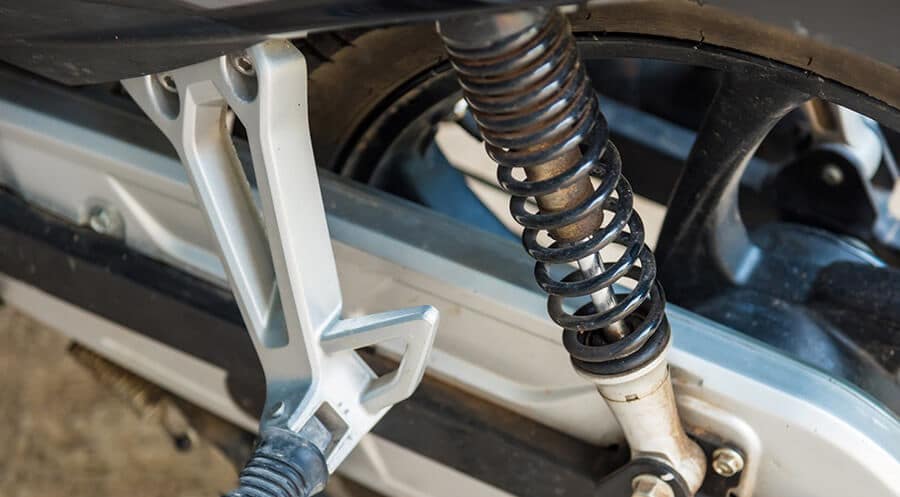
FAQs
Conclusion
Today, spring steel plays a vital role in the production of various items and is expected to maintain its significance across several industrial fields. For instance, it is commonly used in applications that demand components capable of consistently absorbing and reapplying force, such as the spring diaphragms in automobiles and the retractor springs in seat belt systems. The elasticity of spring steel holds a crucial function in the operation of these dynamically stressed parts, determining the amount of force the material can withstand without suffering permanent deformation.
Spring Steel CNC Machining at Runsom Precision
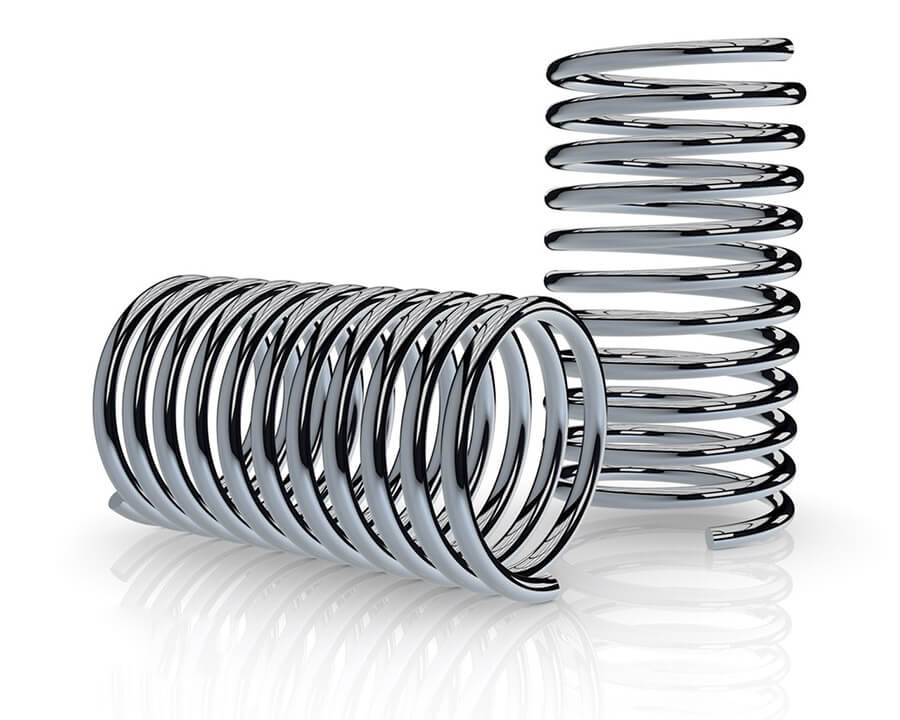
CNC machining spring steel is a relatively complex process, and the selection and use of tools have a very important impact on the quality and efficiency of the process. If you have needs in spring steel machining, reach out to Runsom Precision; we support the machining of a wide range of spring steel materials as well as work hardening and heat treating services. Our experts are well-versed in the technical standards and properties of spring steels to provide the optimal solution for your project. Get an online quote today!
Other Articles You May Be Interested in:

